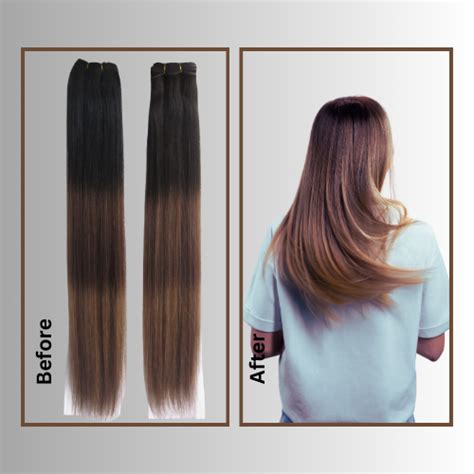Introduction

Black hair is a versatile canvas that can be transformed effortlessly with the magic of extensions. Whether you desire voluminous curls, sleek long lengths, or vibrant pops of color, hair extensions offer endless possibilities to elevate your look. This comprehensive guide will delve into the world of black hair extensions, exploring the different types, techniques, and considerations to help you achieve the perfect hair extension experience.
Types of Hair Extensions
Clip-In Extensions
Clip-in extensions are the most user-friendly option, allowing for quick and easy application without the need for a professional stylist. These extensions come with attached clips that snap securely onto your natural hair. They are suitable for special occasions or temporary hair enhancements.
Tape-In Extensions
Tape-in extensions involve using double-sided adhesive tape to bond thin strands of hair to your natural roots. This semi-permanent method provides a natural-looking blend for a duration of several weeks before requiring removal. Tape-in extensions are ideal for medium to thick hair types.
Sew-In Extensions
Sew-in extensions, also known as weave, involve braiding or sewing donor hair onto your natural hair in cornrows. This method offers long-term wear, lasting up to three months, but requires professional application and regular maintenance. Sew-in extensions are suitable for all hair textures and lengths.
Fusion Extensions
Fusion extensions, or bonded extensions, use a heat-based technique to attach individual strands of hair to your natural locks with a keratin bond. This semi-permanent method can last up to six months but requires a trained stylist for application and removal. Fusion extensions work well on fine to medium hair types.
Choosing the Right Extensions
Hair Texture
Matching the texture of your natural hair to that of the extensions is crucial for a seamless blend. Curly extensions should be paired with curly hair, while straight extensions complement straight hair. Consider texture charts or consulting a professional to determine the best match.
Length
Extensions can add instant length to your hair, but it’s important to choose a length that complements your height and facial features. Short extensions can create a voluminous effect, while longer extensions can add drama and sophistication.
Color
Color matching is essential, especially if you want extensions that blend seamlessly with your natural hair. Consult a professional stylist or use color swatches to ensure the extensions match your desired shade.
Techniques for Applying Extensions
Clip-In Extensions
- Section your hair and create a part where you want to apply the extensions.
- Open the clip and position it close to the roots of your natural hair.
- Snap the clip shut to secure the extension.
- Repeat the process along the part, creating a full row of extensions.
Tape-In Extensions
- Wash and blow-dry your hair thoroughly.
- Create a small section of hair and apply the tape to the base of your roots.
- Press the tape onto your natural hair, ensuring a secure bond.
- Repeat the process along your head, adding as many wefts as needed.
Sew-In Extensions
- Braid your natural hair into cornrows.
- Sew the weft of extensions onto the edge of each cornrow, using a needle and thread.
- Repeat the process until your head is covered with extensions, blending them with your natural hair.
Fusion Extensions
- Divide your hair into small sections.
- Create a small bead at the root of a section of natural hair using a heat tool.
- Insert a strand of extension hair into the bead.
- Clamp the bead with pliers to fuse the extension to your natural hair.
- Repeat the process throughout your head until desired fullness is achieved.
Considerations for Black Hair Extensions
Protecting Natural Hair
Extensions can put stress on your natural hair, so it’s crucial to take proper care to prevent damage. Use gentle shampoos and conditioners designed for extensions and avoid excessive heat styling.
Maintenance
Regular maintenance is essential to keep extensions looking their best. Visit your stylist for professional removals and reapplications, as well as touch-ups for blending and trimming.
Hydration
Extensions can become dry and brittle over time, so it’s important to keep them hydrated. Use leave-in conditioners or deep conditioning treatments specifically designed for extensions.
Styling
Extensions can be styled like your natural hair, but avoid using excessive heat or chemical treatments. Opt for heat protectant sprays and gentle styling tools to minimize damage.
Conclusion
Black hair extensions are a transformative tool that can enhance your hair’s length, volume, and color. By choosing the right type, applying them correctly, and maintaining them regularly, you can achieve a stunning and long-lasting look that complements your natural beauty. Embrace the versatility of hair extensions and enjoy the endless possibilities they offer for expressing your style.
Frequently Asked Questions (FAQs)**
Q: How long do hair extensions last?
A: The lifespan of extensions varies depending on the type chosen. Clip-in extensions can last for occasional use, tape-in extensions for several weeks, sew-in extensions for up to three months, and fusion extensions for up to six months.
Q: Can hair extensions damage my natural hair?
A: If applied incorrectly or maintained poorly, extensions can cause tension and damage to your natural hair. Choose a reputable stylist and follow proper aftercare instructions to minimize the risk.
Q: What is the average cost of hair extensions?
A: The cost of extensions varies depending on the type, length, color, and installation method. Clip-in extensions can range from $50-$200, tape-in extensions from $200-$500, sew-in extensions from $500-$1000, and fusion extensions from $1000-$2000.
Q: Are hair extensions suitable for all hair types?
A: Most types of hair extensions are suitable for all hair textures, but it’s important to consult a professional stylist to determine the best choice for your specific hair needs.
Q: Can I style hair extensions like my natural hair?
A: Yes, you can style extensions using heat tools and styling products, but it’s important to use proper techniques and avoid excessive heat to prevent damage.
